Triflusal reduces dense-core plaque load, associated axonal alterations and inflammatory changes, and rescues cognition in a transgenic mouse model of Alzheimer's disease
- PMID: 20149872
- PMCID: PMC3707138
- DOI: 10.1016/j.nbd.2010.01.019
Triflusal reduces dense-core plaque load, associated axonal alterations and inflammatory changes, and rescues cognition in a transgenic mouse model of Alzheimer's disease
Abstract
Inflammation has been associated with the two classic lesions in the Alzheimer's (AD) brain, amyloid deposits and neurofibrillary tangles. Recent data suggest that Triflusal, a compound with potent anti-inflammatory effects in the central nervous system in vivo, might delay the conversion from amnestic mild cognitive impairment to a fully established clinical picture of dementia. In the present study, we investigated the effect of Triflusal on brain Abeta accumulation, neuroinflammation, axonal curvature and cognition in an AD transgenic mouse model (Tg2576). Triflusal treatment did not alter the total brain Abeta accumulation but significantly reduced dense-cored plaque load and associated glial cell proliferation, proinflammatory cytokine levels and abnormal axonal curvature, and rescued cognitive deficits in Tg2576 mice. Behavioral benefit was found to involve increased expression of c-fos and BDNF, two of the genes regulated by CREB, as part of the signal transduction cascade underlying the molecular basis of long-term potentiation. These results add preclinical evidence of a potentially beneficial effect of Triflusal in AD.
Figures

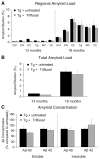

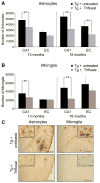
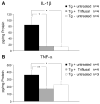
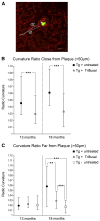
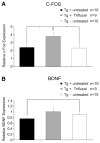
Comment in
-
Thinking outside the box about COX-1 in Alzheimer's disease.Neurobiol Dis. 2010 Jun;38(3):492-4. doi: 10.1016/j.nbd.2010.02.009. Epub 2010 Mar 2. Neurobiol Dis. 2010. PMID: 20206264 Free PMC article.
Similar articles
-
Propranolol reduces cognitive deficits, amyloid and tau pathology in Alzheimer's transgenic mice.Int J Neuropsychopharmacol. 2013 Nov;16(10):2245-57. doi: 10.1017/S1461145713000631. Epub 2013 Jun 17. Int J Neuropsychopharmacol. 2013. PMID: 23768694
-
L-3-n-butylphthalide improves cognitive impairment and reduces amyloid-beta in a transgenic model of Alzheimer's disease.J Neurosci. 2010 Jun 16;30(24):8180-9. doi: 10.1523/JNEUROSCI.0340-10.2010. J Neurosci. 2010. PMID: 20554868 Free PMC article.
-
Peripheral administration of the soluble TNF inhibitor XPro1595 modifies brain immune cell profiles, decreases beta-amyloid plaque load, and rescues impaired long-term potentiation in 5xFAD mice.Neurobiol Dis. 2017 Jun;102:81-95. doi: 10.1016/j.nbd.2017.02.010. Epub 2017 Feb 24. Neurobiol Dis. 2017. PMID: 28237313 Free PMC article.
-
The role of CREB and BDNF in neurobiology and treatment of Alzheimer's disease.Life Sci. 2020 Sep 15;257:118020. doi: 10.1016/j.lfs.2020.118020. Epub 2020 Jun 27. Life Sci. 2020. PMID: 32603820 Review.
-
Drug access to the central nervous system in Alzheimer's disease: preclinical and clinical insights.Pharm Res. 2015 Mar;32(3):819-39. doi: 10.1007/s11095-014-1522-0. Epub 2014 Oct 16. Pharm Res. 2015. PMID: 25319097 Review.
Cited by
-
Activation of glycogen synthase kinase-3 beta mediates β-amyloid induced neuritic damage in Alzheimer's disease.Neurobiol Dis. 2012 Jan;45(1):425-37. doi: 10.1016/j.nbd.2011.09.002. Epub 2011 Sep 13. Neurobiol Dis. 2012. PMID: 21945540 Free PMC article.
-
Presenilin/gamma-Secretase and Inflammation.Front Aging Neurosci. 2010 May 18;2:16. doi: 10.3389/fnagi.2010.00016. eCollection 2010. Front Aging Neurosci. 2010. PMID: 20559464 Free PMC article.
-
Staging anti-inflammatory therapy in Alzheimer's disease.Front Aging Neurosci. 2010 Oct 25;2:142. doi: 10.3389/fnagi.2010.00142. eCollection 2010. Front Aging Neurosci. 2010. PMID: 21152343 Free PMC article.
-
Dissecting phenotypic traits linked to human resilience to Alzheimer's pathology.Brain. 2013 Aug;136(Pt 8):2510-26. doi: 10.1093/brain/awt171. Epub 2013 Jul 3. Brain. 2013. PMID: 23824488 Free PMC article.
-
Cytokine enrichment in deep cerebellar nuclei is contributed by multiple glial populations and linked to reduced amyloid plaque pathology.J Neuroinflammation. 2023 Nov 17;20(1):269. doi: 10.1186/s12974-023-02913-8. J Neuroinflammation. 2023. PMID: 37978387 Free PMC article.
References
-
- Abel T, Kandel E. Positive and negative regulatory mechanisms that mediate long-term memory storage. Brain Res Rev. 1998;26:360–378. - PubMed
-
- Acarin L, et al. Triflusal posttreatment inhibits glial nuclear factor-kappaB, downregulates the glial response, and is neuroprotective in an excitotoxic injury model in postnatal brain. Stroke. 2001;32:2394–2402. - PubMed
-
- Acarin L, et al. Decrease of proinflammatory molecules correlates with neuroprotective effect of the fluorinated salicylate triflusal after postnatal excitotoxic damage. Stroke. 2002;33:2499–2505. - PubMed
Publication types
MeSH terms
Substances
Grants and funding
LinkOut - more resources
Full Text Sources
Medical

